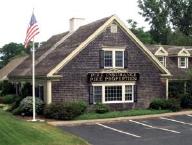|
 |
|
CENTURY 21 Cape Sails |
|
133 Route 6A - Sandwich, MA 02563 |
Cape Cod
Beach Area Properties, Waterfront and
Water View Homes,
Investment Properties, Beach Cottages,
Second and Retirement Homes. |
|
(508) 888-2121 |
Click Here To Visit Our Web Site |
Email Us |
|
|
 |
|
Baxter's Restaurant |
|
Fresh
Seafood Including |
|
Scallops -
Clams - Fish |
|
177 Pleasant
Street - Hyannis |
|
(508)
775-4490 |
|
Visit Our Web Site |
|
|
 |
|
|
 |
|
|
|
The Town of
Eastham is a coastal resort community straddling the arm
of Cape Cod. Located on the lower Cape, the town is
bounded on only two sides by land, the other two being
water, the Atlantic Ocean and Cape Cod Bay. Pre-colonial
stands of oak and pine were long ago harvested for fuel
and shipbuilding and the terrain of the town is now
heavily salt marsh and sand. Dissatisfied with Plymouth,
in 1644 the directors of the Colony sent a seven-man
delegation to scout Eastham for a new site for the
center of government. The decision was not to move, but
the seven members of the delegation brought their
families and established a new town. The town has
several harbors and these and the abundant shellfish are
probably what brought these early settlers from the
Plymouth Colony. The settlers' economy was based on
agriculture, fishing and salt making, but Eastham's
summer resort history began as early as 1830 when the
Methodist Church established a summer camp meeting
ground in town.
The coming of
railroad connections in 1870 stimulated local market
gardening and Eastham specialized in cranberries and
asparagus for the city markets. Eastham had cod and
mackerel fisheries and oysters to ship north. The town's
harbors were not as good as those of other communities
in the area, so agriculture remained more important to
the town in the 19th century than did maritime trades.
Grain production was abundant enough to allow Eastham to
export her grain, while industry was never a real factor
in the town. Residents note, however, that Swift and
Company meatpackers began in Eastham before moving to
Chicago.
Some
original landscapes are still visible in the section of
town inside the National Park areas while intensive
modern residential growth has taken place in other areas
of town.
Web
Site |
|
|
|
|
|
 |
|
|
|
The Town of
Provincetown was incorporated in 1727, but its history
begins much earlier since its well protected harbor
offered excellent protection from storms. The European
explorer Gosnold recorded a stop in Provincetown as
early as 1602 and the harbor was the site of the first
landing of the Mayflower. The Pilgrims signed the
Mayflower compact in the harbor, to codify the way in
which they were going to administer the new colony they
intended to establish. Although rich fishing grounds
resulted in the seasonal leasing of fisheries with
licenses granted for bass, mackerel and cod fishing, the
first permanent settlement didn't take place until 1700.
Provincetown grew very slowly during the 18th century
and its population fluctuated with the price of fish.
Farming was of secondary importance and aside from the
fishing industry, there were only some salt works and
one mill. After the Revolution, the town boomed and its
population rose 276.6% between 1790 and 1830. Despite
its relative lack of good farm land, by the middle of
the 19th century, Provincetown had developed as the
prime maritime, fishing and commercial center of the
Cape. The Civil War, which destroyed so much New England
business, only provided more markets for Provincetown's
fish. Portuguese sailors, picked up by American ships in
the Azores and Cape Verde Islands to fill out their
crews, came to Provincetown to live and additional
Portuguese immigrants had moved to town by the 19th
century to work on the whaling boats and coastal fishing
vessels. In 1875, there were 25 coastwise and 36 ocean
vessels operating in town, more than any community in
the state including Boston. Provincetown was a bustling
place with all of the ancillary maritime businesses
operating, such as ship chandlers, shipwrights, sail
makers, caulkers, riggers and blacksmiths.
The
picturesque setting and salt air also began attracting
artists and writers by the end of the 19th century. This
contingent grew and poets, novelists, journalists,
socialists, radicals and dilettantes formed a colony
which in 1915 opened the Provincetown Players in a
converted fish house on the wharf. Among the writers
whose works were performed there was Eugene O'Neill.
When the fishing industry faltered from competition with
cheaper Nova Scotia cod, and the Portland Gale of 1898
swept away half of the town's wharves, the resort
population of the town provided jobs to take the place
of those lost. In the 1920's the artistic and literary
productions of the town were of international repute and
the abandoned sites of maritime businesses became the
new homes of the seasonal visitor as sail lofts,
warehouses and barns became studios, galleries and
shops. Today, the wealth of preserved historic buildings
combines with the lure of the sea to support a huge
tourist and summer home industry.
Web
Site |
|
|
|
|
|
 |
|
|
|
The Town
of Truro is a small, rural community of Lower Cape Cod
where the quaint and unique character of "Old Cape Cod"
is preserved. Truro is rich in history and strongly tied
to the sea. It is in Truro where the Pilgrims from the
Mayflower found a spring from which they drew their
first drink of water in the new land, and where they
found a cache of Indian corn, at a place named Corn
Hill, that saved them from starvation after their first
year.
Truro
possesses beautiful beaches on Cape Cod Bay and some of
the most magnificent beaches on the Atlantic Ocean. A
source of inspiration to artists and beachcombers alike,
Truro's beaches, dunes and landscape of rolling hills
are an attraction to tourists and vacationers. Home to a
diverse year-round population, Truro's permanent
population includes fishermen, tradesmen and an
ever-growing number of retirees.
The
town is home of the famous Cape Cod Light, Cape Cod's
oldest lighthouse, which was first erected in 1797 and
replaced by the current structure in 1857. The national
landmark is in danger of falling into the ocean due to
erosion, unless the town and area citizens receive
support and cooperation from the federal and state
governments. With over half of its land area within the
Cape Cod National Seashore District, the residents of
Truro are dedicated to preserving the special character
of this seashore community.
Web
Site |
|
|
|
|
|
 |
|
|
|
Located some
seventy five miles out into the Atlantic ocean on the
outer end of Cape Cod, the Town of Wellfleet offers an
abundance of quaint rural sea-side character and charm.
Bounded on the east by the ocean and the west by Cape
Cod Bay, 61% of the land area of Wellfleet is in the
Cape Cod National Seashore Park.
During the
summer, the population swells to an estimated 17,000
persons enjoying the town's miles of ocean and bay-side
beaches; numerous beautiful, clear, spring-fed, ponds;
many fine art galleries, shops and restaurants; and the
magnificent Wellfleet Harbor offering a constantly
changing panorama of sail boats, motor yachts, sport
fishing boats and trawlers.
An
extremely diverse community with an intriguing history
of an extraordinary nautical atmosphere, the friendly
charm of the Central Village provides the pedestrian
with a vast array of browsing, dining, picture-taking
and sight-seeing opportunities within a relatively short
walk. The town is home of the Cape Cod National Seashore
Headquarters as well as the 1,000 acre Massachusetts
Audubon Society Wildlife Sanctuary. Some of Cape Cod's
finest ocean surf-casting, fresh water pond and Cape Cod
Bay boat fishing possibilities are found in Wellfleet,
and the town is well-known for its plentiful supply of
shellfish, including the famous "Wellfleet Oyster".
Web
Site |
|
|
|
|
|
Planning A Visit
To The Cape
...And Need
Assistance?
Call
JustTheCape.com
Toll Free At
1-800-772-7926. |
|
|
|
 |
|
Pike Insurance |
|
Local
People Helping Local People |
|
Our goal is
to provide a personable, quality
customer service level like no
other. At Pike Insurance Agency we
work with you and work for you. |
|
|
Web Site |
8 Main
Street - Orleans, MA |
(508) 255-7880 |
|
|
|